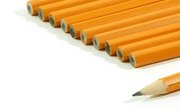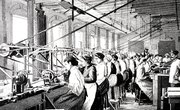Home economics counts as an interdisciplinary degree that focuses on the economics of running a household. In the past, those seeking a degree in the subject, either to teach it or to better run their home farms, took coursework in subjects such as chemistry, food preparation and fine arts. They also took classes in accounting and basic economics. With the recent economic downturn, a look at the subject and its importance has re-emerged.
Proper Nutrition
According to statistics cited in "Today's Dietitian," 35 percent of teenagers have a weight problem with some even being obese. Part of the issue stems from the practice of parents not cooking for their families and opting for fast food instead. Children don't learn about healthy foods and how to prepare them in this environment. One of the primary lessons that a student learns during the course of a home economics education is how to prepare food, about its nutritional value and proper portion sizes. She also learns about how to budget when shopping for food, bringing an additional economics lesson to her studies.
Hospitality and Tourism
When looked at in the broader sense, home economics education doesn't limit itself to people's personal places of residence. Instead, students can take many of the principles taught in a home economics class and apply them to business. The hospitality and tourism industries become prime candidates for this type of education. Aside from the coursework in food science and nutrition, the business and accounting aspects of a home economics program plus the instruction in subjects such as fine art or decorating become useful when looked at in this context, because these skills can be used to decorate a hotel lobby or to choose the look of the interior of a restaurant.
Environmental Sustainability
According to a report by Education for Sustainable Development, the United Nations has declared the years between 2005 and 2014 a time of advancing knowledge about sustainability, as well as taking action to that end. Home economics education has a large part to play in this. Aside from teaching their students about the energy required to grow, package and store food and other items, students in programs such as these learn how to reuse items in new ways. This can include reusing clothing and other household items in different ways than they were originally intended or using recyclable materials when making clothing and other items.
Other Considerations
During the years of World War II, women came out of the home and entered the work force. They also began studying subjects at university, such as journalism and pharmacy, that men once dominated. According to an article by Hannelore Sudermann on the Washington State University website, in order to get women to return to the home, many schools encouraged them to study home economics. Because of this, home economics developed a stigma, particularly during the 60s and 70s when the women's rights movement moved to the forefront of national consciousness. The usefulness of the degree got lost in the rhetoric of the times. However, people working in the realm of the home such as Martha Stewart have begun to shed new light on this subject, making it a more attractive degree option that it has been in years past.
Related Articles
References
Resources
Writer Bio
Buffy Naillon has worked in the media industry since 1999, contributing to Germany's "Der Spiegel" magazine and various websites. She received a bachelor's degree in German from Boise State University. Naillon also attended New York University and participated in the foreign exchange program at Germany's Saarland University. She is completing her master's degree in educational technology at Boise State.











